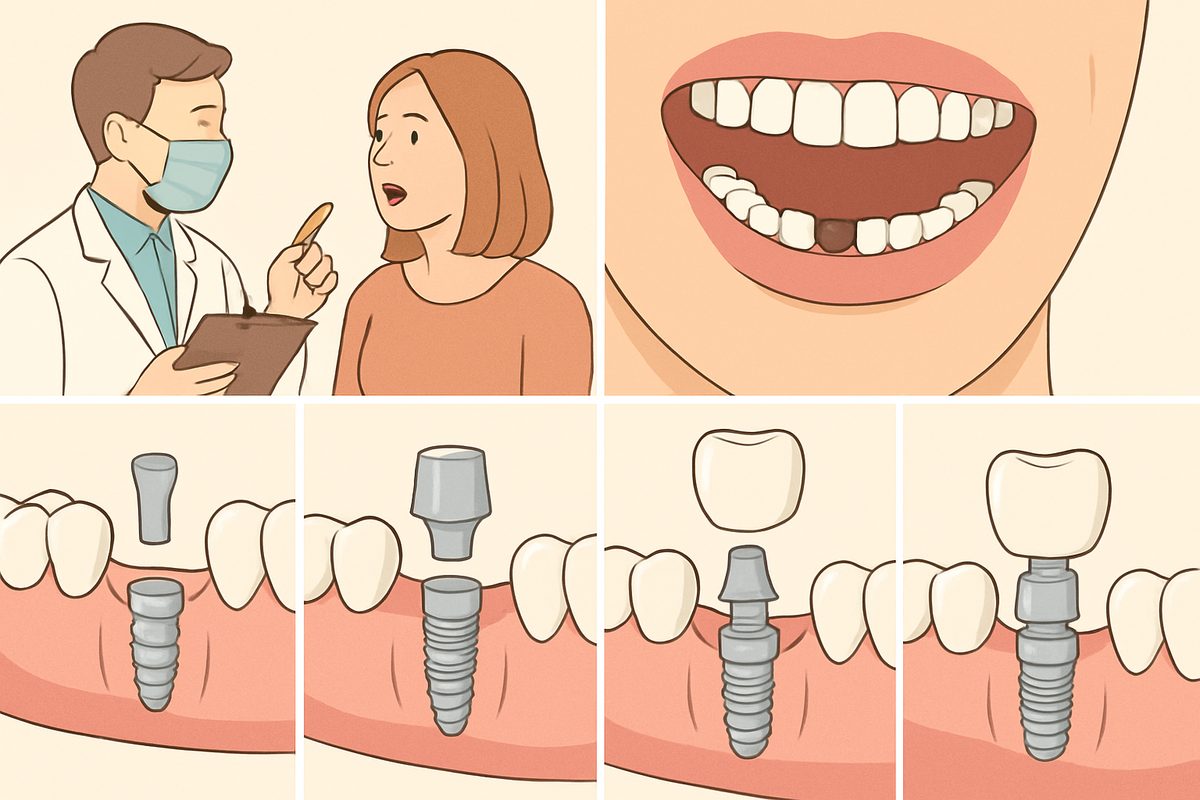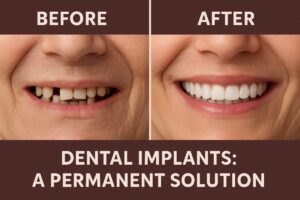If you’re wondering how a tooth implant is done in Fort Wayne, this step-by-step guide will walk you through the typical process, time frame, and expected outcomes. Most implant cases take several months from consultation to final crown, but many patients get a long-lasting, natural-feeling tooth when the process is done correctly.
This guide explains each stage: who is a good candidate, what happens at the first visit, extraction and grafting options, implant surgery, healing (osseointegration), and final crown placement. Read on for practical next steps you can take to learn more about how a tooth implant is done.
Who is a good candidate for a tooth implant?
Good candidates are adults with overall health that supports healing and enough jawbone to hold an implant. Many people qualify, but some conditions can affect success.
- Healthy bone volume or the ability to receive a bone graft
- Healthy gums with no uncontrolled periodontal disease
- Good overall health — chronic conditions like diabetes should be controlled
- Non-smokers are ideal; smokers face higher failure risks
- Age: implants work for most adults; growth must be finished in younger patients
Implants may not be recommended for people with uncontrolled medical conditions, heavy smoking, or poor oral hygiene. Complex cases may need a referral to a specialist (oral surgeon or periodontist).
Initial consultation and treatment planning
At the first visit you’ll get a clinical exam, dental X-rays or a CBCT scan, and a bite evaluation. The dentist will discuss your goals, review costs and options, and answer questions about how a tooth implant is done for your mouth.
Your personalized plan will list steps, timing, and whether extra procedures (extraction or bone graft) are needed. Digital scans or impressions may be taken to design the implant and future crown.
Step 1 — Tooth extraction (if needed)
If a damaged tooth must come out, the dentist will choose a simple or surgical extraction. Simple extractions remove a visible tooth; surgical extractions treat broken roots or impacted teeth. The socket is cleaned to remove infection or debris.
In some cases an implant can be placed immediately into the socket (immediate placement). Other times the site must heal for several weeks before implant placement (delayed placement).
Step 2 — Bone grafting and ridge preservation (if needed)
Bone grafts restore lost bone when the jaw can’t support an implant. Grafts use your own bone, donor material, or synthetic grafts to rebuild volume. Ridge preservation after extraction can limit bone loss.
Healing times vary: small grafts may heal in 6–12 weeks; larger grafts or sinus lifts can take 4–6 months before the implant is placed. This affects the overall timeline for how a tooth implant is done.
Step 3 — Implant surgery: placing the titanium post
On the surgery day the implant (a titanium post) is placed into the jawbone. Anesthesia options include local anesthesia, oral sedatives, or IV sedation. The dentist opens the gum, places the post, and often attaches a healing cap.
Some approaches use immediate loading (temporary tooth placed the same day); others stage the process and wait for healing. Most adult patients feel pressure but little pain during the procedure. Surgery time is usually 30–90 minutes, depending on complexity.
Step 4 — Osseointegration: the healing phase
Osseointegration is when bone bonds to the implant surface. This secure union is what makes implants stable. Typical healing runs from about 3 to 6 months, depending on bone quality and location.
Follow-up checks monitor stability and gum healing. Normal signs include mild swelling and tenderness at first, improving each day. Report increasing pain, pus, or loose implants — these can signal a problem.
Step 5 — Abutment and crown placement
Once the implant is integrated, the abutment (connector) is attached. Impressions or digital scans are taken to make your crown. You may get a temporary crown while the lab makes the final one.
Crowns can be screw-retained or cemented. Screw-retained crowns are easier to remove if maintenance is needed; cemented crowns offer a cleaner look in some cases. Your dentist will recommend the best option.
Common risks and how they’re managed
- Infection — prevented with sterile technique and good oral hygiene; treated with antibiotics if needed
- Implant failure or lack of integration — managed by removal and possible re-grafting
- Nerve or sinus injury — avoided by careful planning and imaging; may require referral if complex
- Peri-implantitis (gum inflammation around implants) — prevented with maintenance and treated with cleaning and, if needed, surgery
Contact your dentist if you have persistent pain, swelling, numbness, or a loose implant.
Aftercare and long-term maintenance
Daily brushing and flossing around the implant are essential. Use interdental brushes or floss designed for implants. During healing, avoid hard or sticky foods on the new implant site.
Regular dental cleanings and check-ups every 3–6 months at first, then every 6–12 months, help implants last many years. Smoking cessation and managing chronic health conditions improve long-term success.
How long it takes and what it typically costs
Timeline summary: consultation (day 1) → extraction (if needed) → possible grafting (weeks to months) → implant surgery (placement) → osseointegration (3–6 months) → abutment and crown (final). Some cases are faster with immediate placement; others take longer with major grafting.
Costs vary based on number of implants, type of crown, grafting or sinus lifts, lab fees, and clinician experience. Ask for a personalized estimate to understand your specific investment in learning how a tooth implant is done in Fort Wayne.
About Sedation & Implant Dentistry and Dr. David Painter
Sedation & Implant Dentistry serves patients in Fort Wayne and Auburn, IN, with decades of implant experience and advanced technology. Dr. David Painter has practiced locally since 1995 and holds certifications in implant care and light-conscious IV sedation. The practice offers modern diagnostics, implant systems, and sedation options to make the process more comfortable for patients learning how a tooth implant is done in Fort Wayne and Auburn, IN.
Summary and next steps if you’re asking “how a tooth implant is done”
In short: a tooth implant is done by planning the case, extracting the tooth if needed, grafting bone when required, placing a titanium implant, waiting for osseointegration, and then attaching an abutment and crown. The full process commonly takes several months but delivers a durable, natural-looking tooth.
If you want to learn more about how a tooth implant is done in Fort Wayne, schedule a consultation with a qualified implant dentist to get a tailored plan, timeline, and cost estimate.






